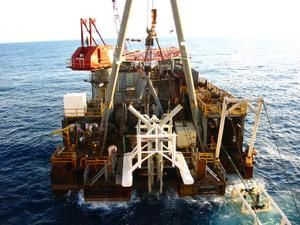 1979, I was still working on the construction of the Rupel tunnel.
1979, I was still working on the construction of the Rupel tunnel.
One of the huge element’s had been placed across the canal a few days earlier and now a small dredger was blowing sand under and around the element to fill all the free spans and so stabilize the construction on the bottom.
My job for that day was to install some measuring equipment at the bottom of a steel pile that was driven at about 30 meters from the quay wall where the diving plant was installed, so that meant that I had to swim to the pile and then go down to do my work at - 24 m.
The underwater installation had taken around 45’ and as I had no more work to do I told the surface that they could recover the diver’s slack to bring me back near the down line that was hanging along the quay.

After a few seconds, my tender informed me that my umbilical was probably fastened somewhere because he couldn’t recover it.
Ok I said, I’ll have a look at it and so I started to follow my hose to see where it was hooked.
It didn’t take long to find the problem. My umbilical was not hooked but on the contrary was completely buried under the sand.
In fact, the sand blown by the dredger had the fucking tendency to spread into the water over a very wide area before it was deposit on the bottom... but also on my breathing hose which at that time was not yet a floating one.
Off course, I tried to pull at it with all my strength but without any success.
As I saw that it was unnecessary to insist, I explained the situation to the surface and told them what I was going to do.
I had decided to free myself from the bottom by disconnecting my umbilical and come up freely to the surface where the surface team would recover me with the zodiac.
Disconnecting our hoses was not difficult for us because in those days, we used a Belgian patented fitting that could easily be connected / disconnected under water or even in mud because the fitting had a self-cleaning device.
After a minute or two the surface informed me that the boat was ready I decided to first test my bail out bottle, so I open the bottle, unscrew the umbilical fitting and … SHIT NO GAS.
Off course, I reconnected my umbilical immediately and started bitching about the big idiot I was for not having checked the pressure of my bail out before the dive.
So again I informed the surface of the slight additional problem stating that this time I expected now be hauled on board as quickly as possible once I reached the surface.
Ok, this time I was ready.
I first pulled out the communication plug, disconnected the karabiner clip from my harness, put a little more gas in my constant volume suit to be slightly positive and finally drop the umbilical.
One off the advantage of this type of suit was due to the fact that in case of gas failure, it was always possible to breathe inside the suit for one or two minutes without having a CO² intoxication, and that’s what I did during my ascent, inspire the expanding gas through the nose, and expire it through my mouth piece to deflate my suit and so avoid an uncontrolled ascent.
I came up only few meters from the zodiac and it took the guys only a few seconds to catch me and pull me in the boat.
"Nice to see you guys" I said.
As I had dived less than an hour on a 45/55 NITROX gas I knew that I had no stops to do, but once on the wall I nevertheless preferred go on pure oxygen for some time because I had probably not respected the prescribed ascent rate.
Finally, all ended well for me except that because of my stupidity I was now obliged to buy a new umbilical.
Conclusion:
- Always test the pressure of your bailout before diving.
Papy One



 En 1979, je travaillais encore sur le chantier du Rupel tunnel. A l’époque, un des énormes éléments venait d’être posé dans le canal et pour le stabiliser sur le fond, une petite drague avait pour mission de rejeter du sable sous et sur les cotés de l’ouvrage.
En 1979, je travaillais encore sur le chantier du Rupel tunnel. A l’époque, un des énormes éléments venait d’être posé dans le canal et pour le stabiliser sur le fond, une petite drague avait pour mission de rejeter du sable sous et sur les cotés de l’ouvrage.

